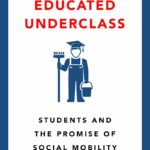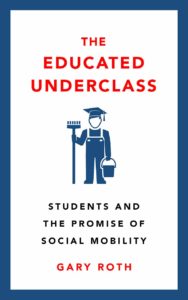From Classroom to Underclass

 Neither a policy paper nor a career guide, Gary Roth’s The Educated Underclass: Students and the Promise of Social Mobility (Pluto Press) is, in the author’s words, “an examination of that edge of reality where education and economy produce results just the opposite of what in theory it is claimed that they do.” Roth is a lecturer in sociology and anthropology, and former vice chancellor and dean, at Rutgers University at Newark.
Neither a policy paper nor a career guide, Gary Roth’s The Educated Underclass: Students and the Promise of Social Mobility (Pluto Press) is, in the author’s words, “an examination of that edge of reality where education and economy produce results just the opposite of what in theory it is claimed that they do.” Roth is a lecturer in sociology and anthropology, and former vice chancellor and dean, at Rutgers University at Newark.
I won’t revisit much of the ground covered in the interview with him that ran at Inside Higher Ed earlier this year. My intent, rather, is to draw out an implication or two of the author’s challenge to some prevalent ways of understanding contemporary American life.
In the quarter century or so following World War II, it is said, someone graduating from high school could find ready employment in the local smokestack industry. Assuming he (no sic here) stayed on the job long enough, he would soon bring home a paycheck ample enough to provide his wife with appliances — and even to begin saving to send their 1.8 children to college, where they would get degrees and soon be white-collar.
All of this was normal and expected: security prevailed. Racial and other inequities that also prevailed will be either ignored or deplored, depending on who tells the story. But one thing not in dispute is that every figure depicted in this myth could (and did) consider themselves middle-class.
“As a lived experience, class is quite complicated,” Roth says. Sociologists — and socialists, for that matter — tend to “apply a limited set of categories” when defining class differences “in order to keep matters simple and intelligible, but they end up distorting the circumstances that people actually live through.” True, a factory worker and his degree-holding professional daughter occupy very different locations relative to the means of production or within the American status system. But the likelihood of both identifying themselves as middle-class has been a major factor in the “lived experience” of class for two or three generations now.
And the role of higher education in consolidating the middle-class standing of both parents and offspring is central — at least, in principle. For one thing, there was the “degree premium.” The holder of a bachelor’s degree tends to earn twice as much as someone who did not finish high school, while the difference in income between the former and someone with a high school diploma “is also substantial,” Roth says, “a divide that over time has only grown wider.” And educational attainment lends “a decided caste-like quality to the transmission of social class across generations.” The book’s first bar graph shows that not quite a third of children raised in families from the highest quartile of income graduate from college if their parents didn’t do so. As for parents who did not go beyond high school, “slightly more than half (53.1 percent) of their children seek more education than they had by attending college.” By contrast, over 80 percent of children from college-educated parents attend college.
In these figures, then, we can make out the formation of a layer of the population — a caste, if you prefer — possessing both educational capital and earning power (if not wealth) transmitted from one generation to the next. Missing from the picture is the capitalist dynamic known as creative destruction.
Or rather, it is cropped out of view, since part of the story of the self-identified American middle class is de-industrialization. Roth supplies the facts and figures showing that huge structural changes were underway well before that factory with the smokestack, mentioned earlier, was shut down. Between 1950 and 1970, “white-collar professions overtook traditional manual occupations and accounted for nearly half of all employment nationwide,” with blue-collar jobs falling to about a third of the total.
This transformation is often postdated to later decades and equated with a turn away from manufacturing and the rise of the service sector, though the number of service workers grew more than three times faster than manual workers did over the same period between 1950 and 1970. Both white-collar and service-sector employment have bifurcated into “high-waged positions within the managerial, professional and technical fields” at one end and a far larger pool of worse-paid, more precarious jobs at the other.
Colleges and universities have been major centers for research that have boosted worker productivity, whatever the color of the collar. In doing so, they help generate jobs requiring new skills and cognitive capacities, while also developing and certifying the pools of those who can perform them. Existing jobs are wiped out by innovation and automation, to be replaced by new jobs — for however long they are needed before the next round of innovation wipes them out. “Higher education has become a type of warehousing … whereby the academically gifted among the potentially unemployed are transformed instead into the underemployed.”
The waste of human capacity Roth describes is phenomenal. But his major point is that it is not new. The millennials are feeling the worst of it, perhaps, but only the worst so far.
“To be born near the bottom or the top of the income and wealth spectrums increases dramatically your chances of remaining nearby throughout your life,” Roth writes. “For everyone else in the vast middle, intense pressure and frequent movement up and down the income spectrum ultimately result in very little change at all. Temporary fluctuations can be quite dramatic, but generally not long lasting enough to permanently alter your life circumstances. Stagnation and near-stagnation have engulfed 80 percent of the population for three generations already.” Three and counting.
Originally posted at Inside Higher Ed.